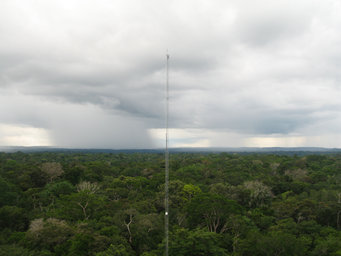Amazon rain helps make more rain
In the Amazon region, downdrafts bring aerosol particles from higher altitudes to the atmospheric layer where clouds form.
In a joint study, international scientists investigated how clouds and hence rain develops over the Amazon tropical rainforest. They found out that the rain is generating further rain by downdrafts entraining fine particles from the upper atmospheric layers to the layer where clouds are formed. As, in this area, there are no cloud condensation particles from anthropogenic pollution, these findings are important to help understand how precipitation developed in preindustrial times.

For clouds to form in the atmosphere, moisture alone is not sufficient: there must also be aerosol particles that serve as condensation nuclei for the cloud droplets. Some particles such as mineral dust, sea salt or pollen are directly emitted from the ground and held aloft by normal air circulation. However, the majority of particles is formed from atmospheric gas molecules and starts out at a size of only a few millionths of a millimeter (nanometers). They subsequently grow to a diameter where they can serve as condensation nuclei for fog, clouds, and precipitation.
For densely populated and polluted areas, the mechanism behind new particle formation is very well known: emissions from fossil fuel burning release sulfur dioxide, which then forms particles of sulfuric acid. This is not the case in the Amazon rain forest, one of the most pristine regions of the world. Here, the sulfuric acid particles from anthropogenic sources are missing and the atmosphere in the rainy season is almost as clear as in preindustrial times. Therefore, an international team of scientists investigated the origin of aerosol particles at a very remote location in the natural forest. This will help answer the question how cloud formation and precipitation worked in preindustrial times.
Downdrafts transport particles to lower layers
Among the research team were scientists from the Max Planck Institutes for Chemistry, Mainz, and Biogeochemistry, Jena, Germany. They could show that downdrafts above the rain forest are responsible for the transport of the finest particles down to lower layers. These downdrafts form in the presence of precipitation and thunderstorms. They entrain the smaller particles from the upper troposphere at a height of several kilometers downwards and feed the boundary layer close to the ground surface with aerosol particles. Out of this layer, which is only one to two kilometers high, grow the clouds that produce the rain that the forest needs. “In the rain forest, the nursery for the smaller aerosol particles is not in the lower part of the atmosphere as it is the case in polluted areas, but at much higher altitudes,” comments Christopher Pöhlker, scientific group leader at Max Planck Institute for Chemistry .
In this article, the scientists explain how they measured the size and concentration of the aerosol particles above the tropical rain forest. They took advantage of the Amazon Tall Tower Observatory (ATTO) located at about 150 km northeast of Manaus in the middle of the primeval forest. This measurement station is jointly managed by the Brazil Institute for Amazon Research (INPA) and the Max Planck Society. At a height of 60 meters, well above the tree canopy, the research team collected air samples that were analyzed for the number and size of aerosol particles. The particle distribution at this level is very representative for the distribution in the atmospheric boundary layer, because the air is well mixed throughout this layer.
Aerosols in the troposphere
In addition, aerosol sampling and analysis was carried out at several heights and times on board the research aircraft Gulfstream-1 of the U.S. Department of Energy. The scientists observed that the concentration of the smallest particles, with a diameter smaller than 50 nanometers, was very high in the upper troposphere. At the ground station, they registered a substantial increase in the smaller particles after rain or storm events. While the average particle size was around 100 nanometers before the precipitation events, it dropped to below 50 nanometers directly after the rain. This is explained by the downdrafts that accompany rainy and stormy weather conditions and entrain the smaller particles from the upper troposphere to the near-ground boundary layer. Here, they can grow to larger particles, which can serve as condensation nuclei for cloud formation. One can say that rain makes for even more rain in the Amazon.
Next, the researchers are curious about the precise origin of the smaller aerosol particles in the upper troposphere. However, they already have some clues from still unpublished measurements performed by the German HALO research aircraft over the Amazon: “These particles probably derive from chemical reactions in the upper troposphere,” states Meinrat O. Andreae, director at the Max Planck Institute for Chemistry in Mainz. “If we can prove this hypothesis, we will make substantial progress in understanding how precipitation processes worked before humans irreversibly altered our environment and especially the atmosphere,” he adds with a view towards the Anthropocene.
The results of this study performed by researchers from Brazil, China, Germany, Finland, Sweden and the USA have another important impact: Aerosols play an important role in climate modeling and represent a major uncertainty factor in the computer models, also because it is not well understood how aerosols form under natural conditions. These new findings on the origin of the small particles above the tropical rain forest will help improve predictions on climate change as well.
SB/HR












